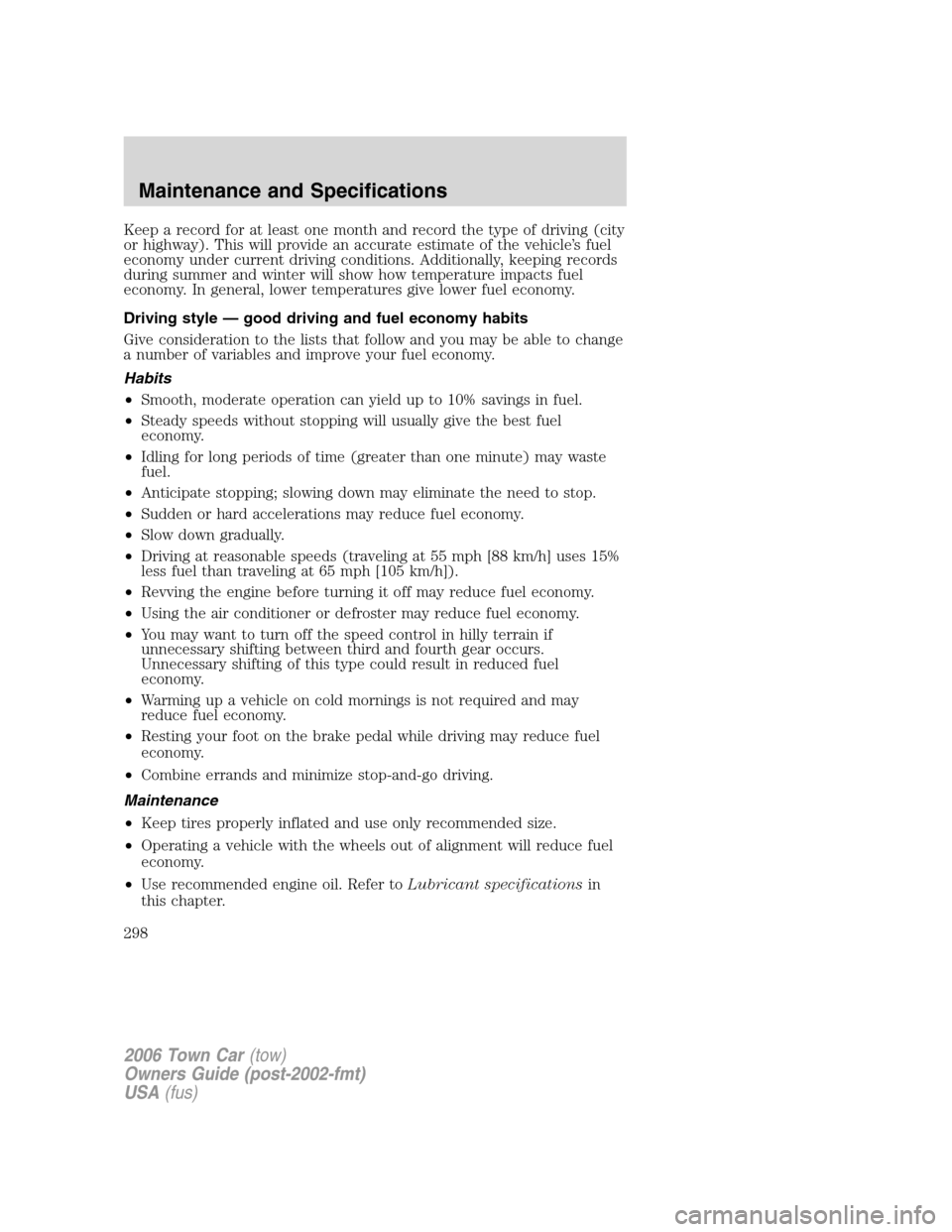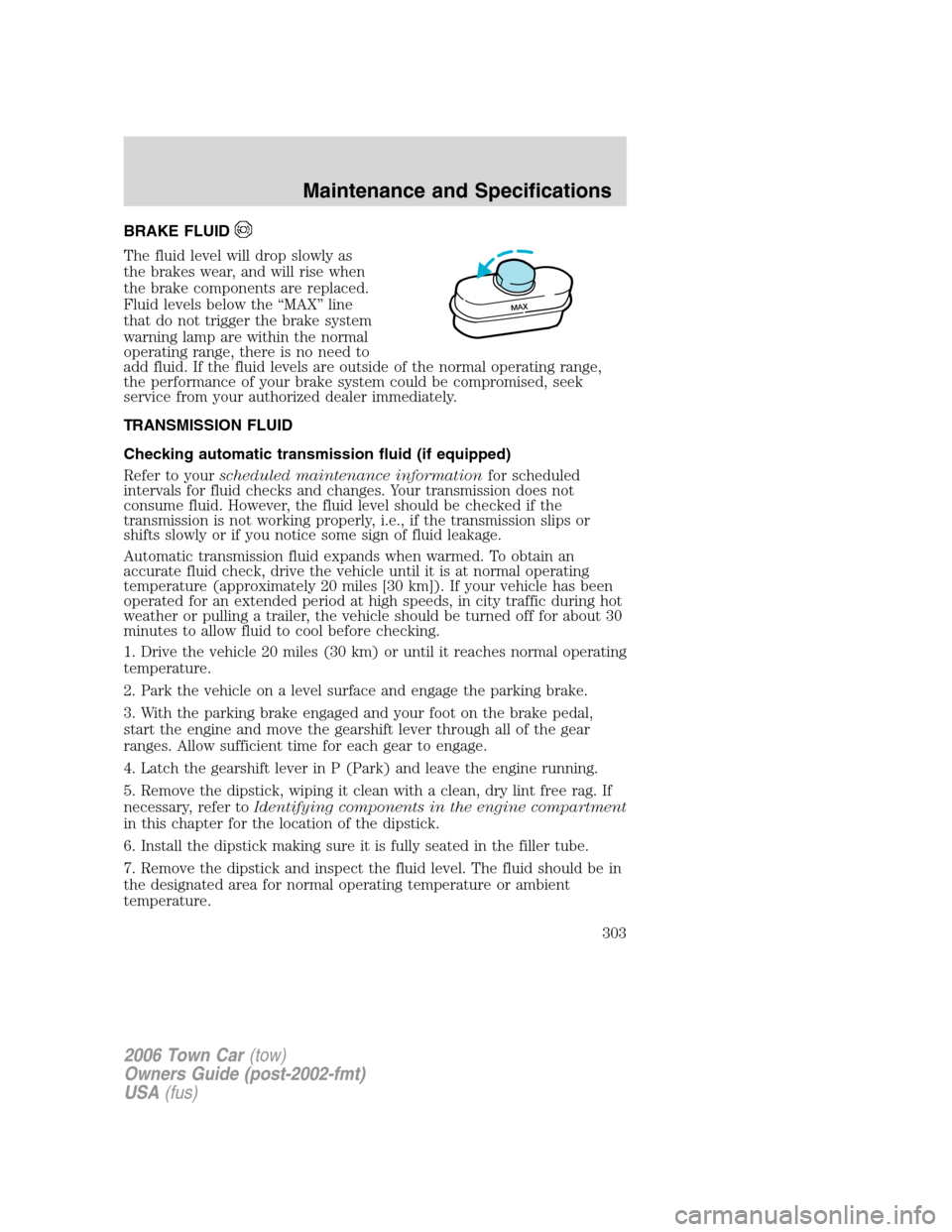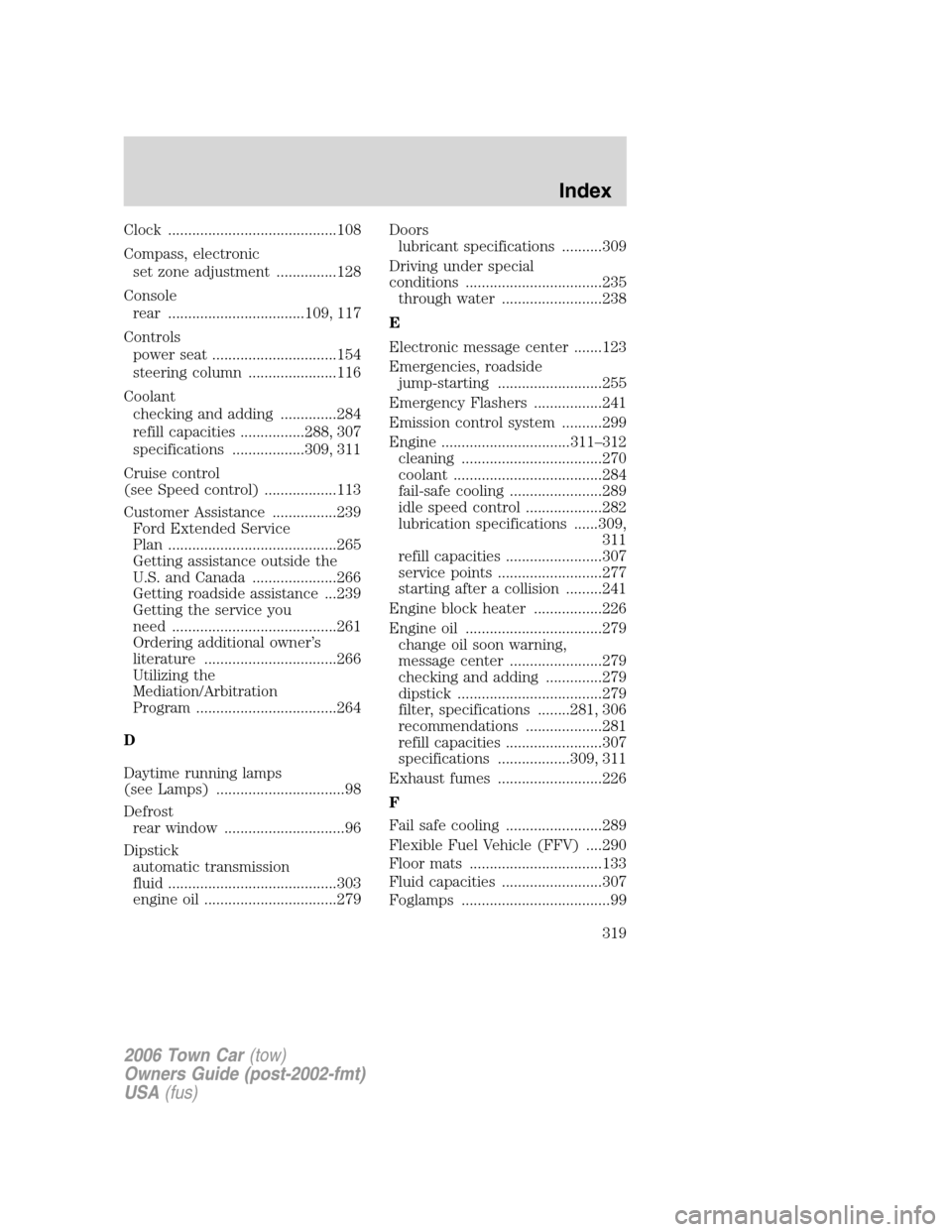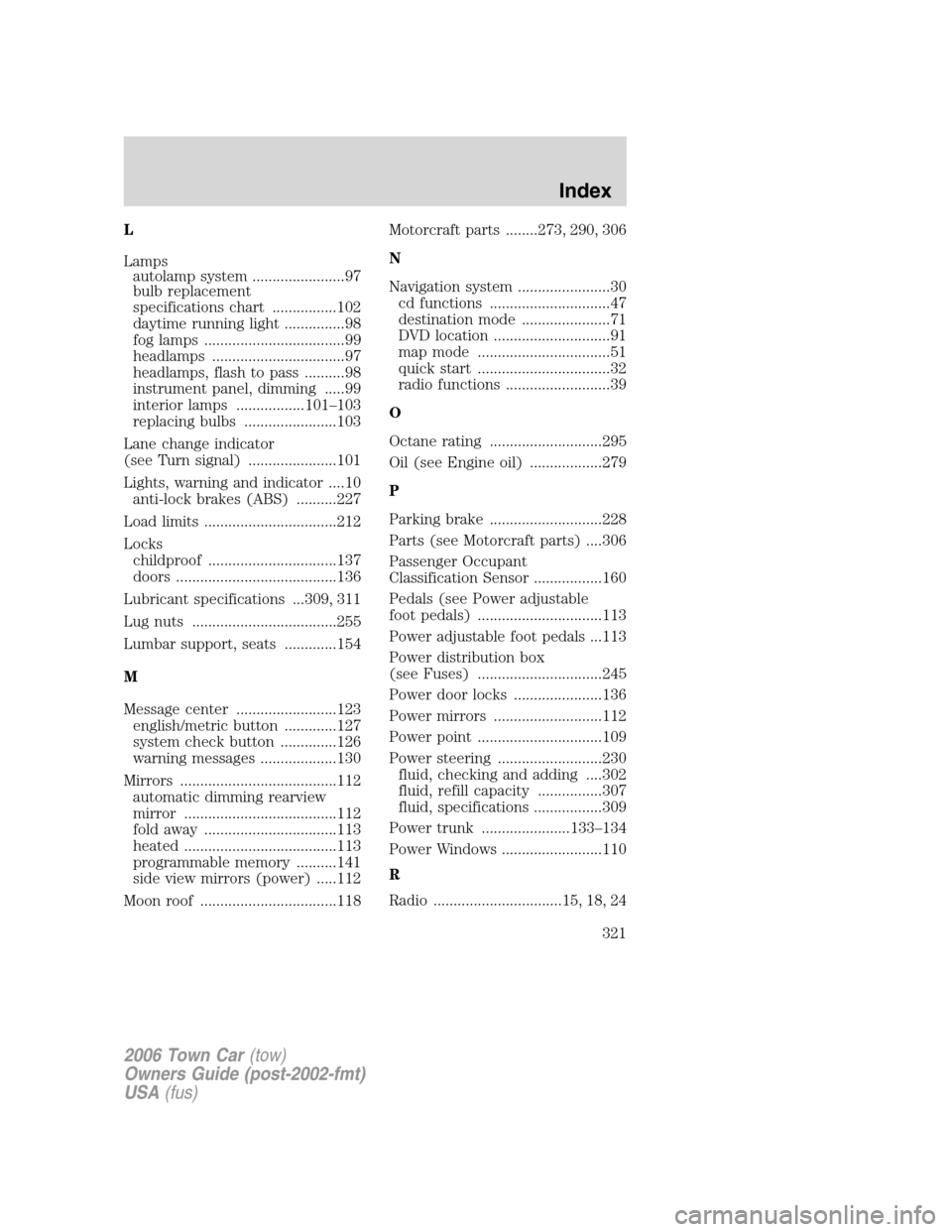2006 LINCOLN TOWN CAR change time
[x] Cancel search: change timePage 264 of 328

THE BETTER BUSINESS BUREAU (BBB) AUTO LINE PROGRAM
(U.S. ONLY)
Your satisfaction is important to Ford Motor Company and to your dealer.
Experience has shown that our customers have been very successful in
achieving satisfaction by following the three-step procedure outlined on
the front page of the Warranty Guide. However, if your warranty concern
has not been resolved using the three-step procedure, you may be
eligible to participate in the BBB AUTO LINE program.
The BBB AUTO LINE program consists of two parts – mediation and
arbitration. Initially, the BBB will try to resolve your question or concern
through mediation. Mediation is a process through which a
representative of the BBB will contact the parties and explore options
for settlement of your claim. If mediation is not successful, customers
with eligible claims may participate in the BBB AUTO LINE arbitration
process. An arbitration hearing will be scheduled so that you can present
your case in an informal setting before an impartial person. The
arbitrator will consider the testimony provided and make a decision after
the hearing. You are not bound by the decision but may choose to accept
it. If you choose to accept the BBB AUTO LINE decision then Ford must
abide by the accepted decision as well. If the arbitrator has decided in
your favor and you accept the decision, the BBB AUTO LINE program
will contact you to ensure that Ford has complied with the decision in a
timely manner. Disputes submitted to the BBB AUTO LINE program are
usually decided within forty days after you file your claim with the BBB.
To file a claim with the BBB AUTO LINE, you will be asked for your
name and address, information about your vehicle, information about
your concerns and any steps you have already taken to try to resolve
them.
You can get more information by calling BBB AUTO LINE at
1–800–955–5100, or writing to:
BBB AUTO LINE
4200 Wilson Boulevard, Suite 800
Arlington, Virginia 22203–1833
Note:Ford Motor Company reserves the right to change eligibility
limitations, modify procedures, or to discontinue this process at any time
without notice and without obligation.
UTILIZING THE MEDIATION/ARBITRATION PROGRAM
(CANADA ONLY)
For vehicles delivered to authorized Canadian dealers. In those cases
where you continue to feel that the efforts by Ford of Canada and the
2006 Town Car(tow)
Owners Guide (post-2002-fmt)
USA(fus)
Customer Assistance
264
Page 265 of 328

authorized dealer to resolve a factory-related vehicle service concern
have been unsatisfactory, Ford of Canada participates in an impartial
third party mediation/arbitration program administered by the Canadian
Motor Vehicle Arbitration Plan (CAMVAP).
The CAMVAP program is a straight-forward and relatively speedy
alternative to resolve a disagreement when all other efforts to produce a
settlement have failed. This procedure is without cost to you and is
designed to eliminate the need for lengthy and expensive legal
proceedings.
In the CAMVAP program, impartial third-party arbitrators conduct
hearings at mutually convenient times and places in an informal
environment. These impartial arbitrators review the positions of the
parties, make decisions and, when appropriate, render awards to resolve
disputes. CAMVAP decisions are fast, fair, and final as the arbitrator’s
award is binding both to you and Ford of Canada.
CAMVAP services are available in all territories and provinces. For more
information, without charge or obligation, call your CAMVAP Provincial
Administrator directly at 1-800-207-0685.
FORD EXTENDED SERVICE PLAN
You can get more protection for your new car or light truck by
purchasing Ford Extended Service Plan (Ford ESP) coverage. It provides
the following:
•Benefits during the warranty period depending on the plan you
purchase (such as: reimbursement for rentals; coverage for certain
maintenance and wear items).
•Protection against covered repair costs after your Bumper-to-Bumper
Warranty expires.
You may purchase Ford ESP from any participating authorized dealer.
There are several plans available in various time, distance and deductible
combinations which can be tailored to fit your own driving needs. Ford
ESP also offers reimbursement benefits for towing and rental coverage.
When you buy Ford ESP, you receive Peace-of-Mind protection
throughout the United States and Canada, provided by a network of
more than 4,600 participating authorized dealers.
If you did not take advantage of the Ford Extended Service Plan at the
time of purchasing your vehicle, you may still be eligible. Since this
information is subject to change, please ask your authorized dealer for
complete details about Ford Extended Service Plan coverage options, or
visit the Ford ESP website at www.ford-esp.com.
2006 Town Car(tow)
Owners Guide (post-2002-fmt)
USA(fus)
Customer Assistance
265
Page 298 of 328

Keep a record for at least one month and record the type of driving (city
or highway). This will provide an accurate estimate of the vehicle’s fuel
economy under current driving conditions. Additionally, keeping records
during summer and winter will show how temperature impacts fuel
economy. In general, lower temperatures give lower fuel economy.
Driving style — good driving and fuel economy habits
Give consideration to the lists that follow and you may be able to change
a number of variables and improve your fuel economy.
Habits
•Smooth, moderate operation can yield up to 10% savings in fuel.
•Steady speeds without stopping will usually give the best fuel
economy.
•Idling for long periods of time (greater than one minute) may waste
fuel.
•Anticipate stopping; slowing down may eliminate the need to stop.
•Sudden or hard accelerations may reduce fuel economy.
•Slow down gradually.
•Driving at reasonable speeds (traveling at 55 mph [88 km/h] uses 15%
less fuel than traveling at 65 mph [105 km/h]).
•Revving the engine before turning it off may reduce fuel economy.
•Using the air conditioner or defroster may reduce fuel economy.
•You may want to turn off the speed control in hilly terrain if
unnecessary shifting between third and fourth gear occurs.
Unnecessary shifting of this type could result in reduced fuel
economy.
•Warming up a vehicle on cold mornings is not required and may
reduce fuel economy.
•Resting your foot on the brake pedal while driving may reduce fuel
economy.
•Combine errands and minimize stop-and-go driving.
Maintenance
•Keep tires properly inflated and use only recommended size.
•Operating a vehicle with the wheels out of alignment will reduce fuel
economy.
•Use recommended engine oil. Refer toLubricant specificationsin
this chapter.
2006 Town Car(tow)
Owners Guide (post-2002-fmt)
USA(fus)
Maintenance and Specifications
298
Page 303 of 328

BRAKE FLUID
The fluid level will drop slowly as
the brakes wear, and will rise when
the brake components are replaced.
Fluid levels below the “MAX” line
that do not trigger the brake system
warning lamp are within the normal
operating range, there is no need to
add fluid. If the fluid levels are outside of the normal operating range,
the performance of your brake system could be compromised, seek
service from your authorized dealer immediately.
TRANSMISSION FLUID
Checking automatic transmission fluid (if equipped)
Refer to yourscheduled maintenance informationfor scheduled
intervals for fluid checks and changes. Your transmission does not
consume fluid. However, the fluid level should be checked if the
transmission is not working properly, i.e., if the transmission slips or
shifts slowly or if you notice some sign of fluid leakage.
Automatic transmission fluid expands when warmed. To obtain an
accurate fluid check, drive the vehicle until it is at normal operating
temperature (approximately 20 miles [30 km]). If your vehicle has been
operated for an extended period at high speeds, in city traffic during hot
weather or pulling a trailer, the vehicle should be turned off for about 30
minutes to allow fluid to cool before checking.
1. Drive the vehicle 20 miles (30 km) or until it reaches normal operating
temperature.
2. Park the vehicle on a level surface and engage the parking brake.
3. With the parking brake engaged and your foot on the brake pedal,
start the engine and move the gearshift lever through all of the gear
ranges. Allow sufficient time for each gear to engage.
4. Latch the gearshift lever in P (Park) and leave the engine running.
5. Remove the dipstick, wiping it clean with a clean, dry lint free rag. If
necessary, refer toIdentifying components in the engine compartment
in this chapter for the location of the dipstick.
6. Install the dipstick making sure it is fully seated in the filler tube.
7. Remove the dipstick and inspect the fluid level. The fluid should be in
the designated area for normal operating temperature or ambient
temperature.
MAX
2006 Town Car(tow)
Owners Guide (post-2002-fmt)
USA(fus)
Maintenance and Specifications
303
Page 319 of 328

Clock ..........................................108
Compass, electronic
set zone adjustment ...............128
Console
rear ..................................109, 117
Controls
power seat ...............................154
steering column ......................116
Coolant
checking and adding ..............284
refill capacities ................288, 307
specifications ..................309, 311
Cruise control
(see Speed control) ..................113
Customer Assistance ................239
Ford Extended Service
Plan ..........................................265
Getting assistance outside the
U.S. and Canada .....................266
Getting roadside assistance ...239
Getting the service you
need .........................................261
Ordering additional owner’s
literature .................................266
Utilizing the
Mediation/Arbitration
Program ...................................264
D
Daytime running lamps
(see Lamps) ................................98
Defrost
rear window ..............................96
Dipstick
automatic transmission
fluid ..........................................303
engine oil .................................279Doors
lubricant specifications ..........309
Driving under special
conditions ..................................235
through water .........................238
E
Electronic message center .......123
Emergencies, roadside
jump-starting ..........................255
Emergency Flashers .................241
Emission control system ..........299
Engine ................................311–312
cleaning ...................................270
coolant .....................................284
fail-safe cooling .......................289
idle speed control ...................282
lubrication specifications ......309,
311
refill capacities ........................307
service points ..........................277
starting after a collision .........241
Engine block heater .................226
Engine oil ..................................279
change oil soon warning,
message center .......................279
checking and adding ..............279
dipstick ....................................279
filter, specifications ........281, 306
recommendations ...................281
refill capacities ........................307
specifications ..................309, 311
Exhaust fumes ..........................226
F
Fail safe cooling ........................289
Flexible Fuel Vehicle (FFV) ....290
Floor mats .................................133
Fluid capacities .........................307
Foglamps .....................................99
2006 Town Car(tow)
Owners Guide (post-2002-fmt)
USA(fus)
Index
319
Page 321 of 328

L
Lamps
autolamp system .......................97
bulb replacement
specifications chart ................102
daytime running light ...............98
fog lamps ...................................99
headlamps .................................97
headlamps, flash to pass ..........98
instrument panel, dimming .....99
interior lamps .................101–103
replacing bulbs .......................103
Lane change indicator
(see Turn signal) ......................101
Lights, warning and indicator ....10
anti-lock brakes (ABS) ..........227
Load limits .................................212
Locks
childproof ................................137
doors ........................................136
Lubricant specifications ...309, 311
Lug nuts ....................................255
Lumbar support, seats .............154
M
Message center .........................123
english/metric button .............127
system check button ..............126
warning messages ...................130
Mirrors .......................................112
automatic dimming rearview
mirror ......................................112
fold away .................................113
heated ......................................113
programmable memory ..........141
side view mirrors (power) .....112
Moon roof ..................................118Motorcraft parts ........273, 290, 306
N
Navigation system .......................30
cd functions ..............................47
destination mode ......................71
DVD location .............................91
map mode .................................51
quick start .................................32
radio functions ..........................39
O
Octane rating ............................295
Oil (see Engine oil) ..................279
P
Parking brake ............................228
Parts (see Motorcraft parts) ....306
Passenger Occupant
Classification Sensor .................160
Pedals (see Power adjustable
foot pedals) ...............................113
Power adjustable foot pedals ...113
Power distribution box
(see Fuses) ...............................245
Power door locks ......................136
Power mirrors ...........................112
Power point ...............................109
Power steering ..........................230
fluid, checking and adding ....302
fluid, refill capacity ................307
fluid, specifications .................309
Power trunk ......................133–134
Power Windows .........................110
R
Radio ................................15, 18, 24
2006 Town Car(tow)
Owners Guide (post-2002-fmt)
USA(fus)
Index
321